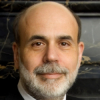Ben Bernanke

Ben Bernanke
Ben Shalom Bernankeis an American economist at the Brookings Institution who served two terms as chairman of the Federal Reserve, the central bank of the United States, from 2006 to 2014. During his tenure as chairman, Bernanke oversaw the Federal Reserve's response to the late-2000s financial crisis. Before becoming Federal Reserve chairman, Bernanke was a tenured professor at Princeton University and chaired the department of economics there from 1996 to September 2002, when he went on public service leave...
NationalityAmerican
ProfessionPolitician
Date of Birth13 December 1953
CityAugusta, GA
CountryUnited States of America